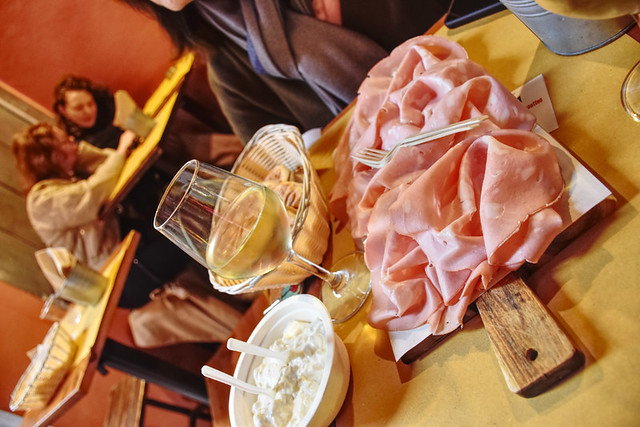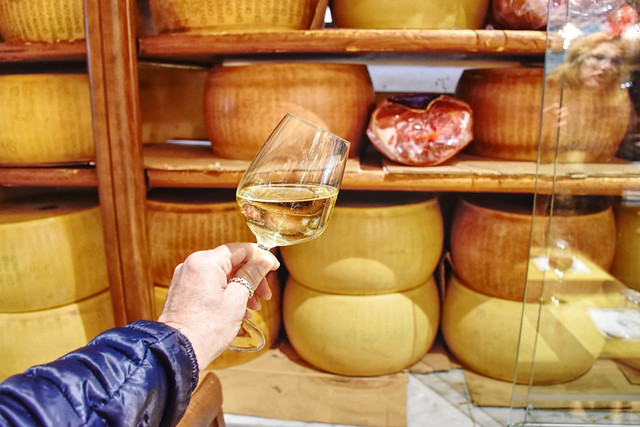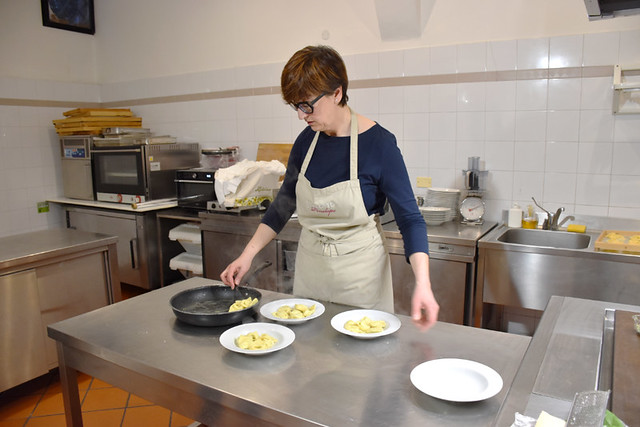Trips to Italy never disappoint the tastebuds – whether they have involved eating our way through elaborate Michelin star tasting menus on the banks of the Italian Lakes or tucking into pizza margherita in a dimly-lit backstreet in Pisa. Our most recent exploration was a dream job in that it involved putting together a gastronomy odyssey through Italy’s Food Valley, considered the culinary heart of the country. Surprisingly, the tastiest and most memorable aspects of that journey didn’t cost the earth, as many of them didn’t involve eating in restaurants. Every day delivered delicious delights. Sometimes these involved surprising takes on classic Italian specialities. But often the food we were presented with was unfamiliar. These are ten of our favourite food experiences in Emilia Romagna.
Piadina on the Pavement, Bologna
Eating piadina on the pavement in Bologna takes the number one spot because it was our first gastronomic venture in Emilia Romagna. It’s a simple concept – a filled flat bread which is like a cross between a wrap and a sandwich. As well as tasting great, the fillings are an introduction to some of the region’s cured meats (salami, mortadella, prosciutto) and cheeses (squacquerone, Parmigiano). Piadinas from La Piadeina on Via Calzolerie on the fringes of the Quadrilatero district cost around €6.
Mortadella and Tigelle, Bologna
Bologna’s Quadrilatero district is Valhalla for foodies, and just as lively as the mythical Norse Hall. Often, a good way to dive into a new food scene is to ask for whatever everyone else is eating. This approach was how we discovered francesinhas in Porto. Outside the Quadrilatero’s bustling bars, punters were picking at mountains of mortadella accompanied by bowls of creamy cheese (squacqerone) and baskets of warm, round bread cakes (tigelle). So, we copied them and re-discovered just how good mortadella is. A combination of the mortadella, squacquerone and tigelle comes in at under €20.
An aperitif in Parma
The first time we were presented with nibbles with our drinks was in Modena, but it’s the aperitifs in Parma that stick most in my memory. The popular place to go for an early evening drink is on Via Farini, but at the end of a long day pounding Parma’s lovely streets, we found ourselves outside Gran Caffé Cavour at the opposite end of Strada Cavour. Initially, I grumbled at the lack of snacks served with the craft beers we’d ordered. A few minutes later I was eating my words, and a whole lot more as a circular slate with nine substantial nibbles appeared.
Horse meat paninis, Parma
Raw horse meat is a thing in Parma. The perfect opportunity to try some arose when local food expert Sara shared a favourite panini joint of hers, Da Pepén. It’s a non-descript place we’d have otherwise walked past, especially given there was a queue of locals outside and the ordering process looked complicated. Basically, you make your way to the till, place your order, get a ticket, and wait until your pesto di cavallo crudo panini (€7) is freshly made. The done thing is to order a glass of malva (malvasia) to sip in the street outside while waiting. Incidentally, there are loads of other tasty paninis; it doesn’t have to be horse meat.
Eating in a deli, Parma
As well as being foodie treasure troves where locals do much of their food shopping, Parma’s delicatessens, called prosciuterrias and salumerias, are fascinating places to sample the best of Emilia Romagna’s produce. I don’t just mean asking for a taste before buying. Some, like Salumeria Garibaldi, have a handful of tables and chairs where you can sit in and enjoy a selection of goodies. We spent a significant chunk of an afternoon picking at platters of cured meats – prosciutto di Parma, salami feline, coppa di Parma – followed by buttery ravioli, all the while nosying at what the locals were buying. We also picked up a kilo of Parmigiano Reggiano (Parmesan cheese) to take home.
Gnocco Frito in Modena
Little fried golden pillows traditionally made from flour and lard regularly put in appearances on the dining tables of Emilia Romagna, irrespective of where you happen to be. In Parma they’re called torta fritta. Further east, they’re known as gnocco frito. I associate them most with Modena because that’s where I first saw them, on the entertaining and informative Netflix food and travel series Somebody Feed Phil, where host Phil Rosenthal dipped them in his morning coffee. You can just eat them on their own, they’re highly addictive, or cut them open and pop cheese and/or ham inside to make a mini sandwich.
Balsamic vinegar tasting in Albinelli Market
We usually have a bottle of balsamic vinegar in our kitchen cupboard. It is nothing like any of the balsamic vinegars we tried beneath the Art Nouveau arches of Modena’s Albinelli Market, an ideal venue for sampling a selection of Modena’s products, from sour cherry tarts to green lasagne. For a start, the balsamic vinegar we pick up at the supermarket is more than likely a condimento, a less intense version used in pasta dishes and on cheese. The real deal, Aceta Balsamico Tradizionale di Modena is thick, almost syrupy with a sweet and sour flavour, and can only be sold in 100ml bottles with a specific design. We tried various vinegars with a selection of tapas-like snacks (€7) and bought a condimento at €7, plus a bottle of the really good stuff for €45, a bargain when you learn some of the prices.
Cheese and wine in Reggio Emilia
Modena doesn’t attract as many tourists as Bologna or Parma. Its neighbour, Reggio Emilia attracts even fewer. Yet, in gastronomic and cultural terms, it can hold its own. It has its own version of balsamic vinegar, and Parmigiano Reggiano, which some locals claim is the best in the region as it is made using milk from vacche rosso, red cows. We got to try both at Antica Salumeria Giorgio Pancaldi, another one of those superb Italian gastro-shrines which are a fusion of deli and restaurant. Were they better? I couldn’t say, but they were just as good. A bonus was they were accompanied by a glass of spergola, a very drinkable sparkling wine that even the wine experts at my local Majestic had never heard of.
Coffee and tagliatelle with a difference, Reggio Emilia
One of the surprising things about gastronomy throughout Emilia Romagna was the number of times what we thought we knew about certain products/dishes was turned on its head. At atmospheric Pasticceria Boni we ate tagliatelle accompanied by a cup of coffee where neither were quite as they sound. The tagliatelle came in cake form, the tagliatelle bit being the cake’s crispy topping. The coffee wasn’t coffee at all but caffé d’orzo which looks like coffee but is made from barley. It’s drunk by Italians to keep their caffeine intake down and is far superior to the chicory-flavoured substitute that used to be popular in Britain.
Eating our own pasta, Bologna
The ultimate gastro experience in Emilia Romagna was eating pasta dishes we made ourselves. Under the guidance of a local cook, and with two other pasta-making novices from the US, we spent three hours learning how to make pasta dough from scratch and then turn that dough into tagliatelle, ravioli, and tortellini. The time whizzed past as everything we knew about making pastas and Bolognese sauce was dismissed and we learnt the proper way, the Italian way. It was entertaining, hugely informative, especially for people who are into cooking, delicious (thanks to the expert guidance), and very filling. Three pasta dishes are a lot to get through. Thankfully, there was plenty of wine to wash them down. It wasn’t cheap, around €120pp, but it was great value for money as it was one of the most enjoyable travel/food experiences we’ve had.
But then I could say that about many of our gastronomic experiences in Emilia Romagna; there is a very good reason why it’s known as Italy’s Food Valley.














Be the first to comment